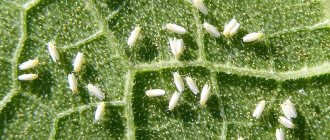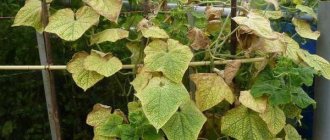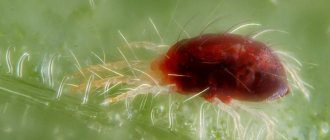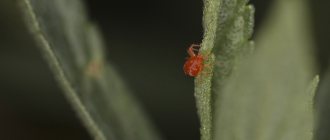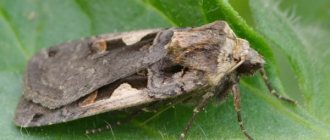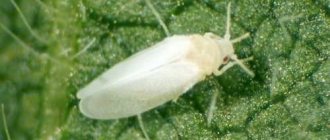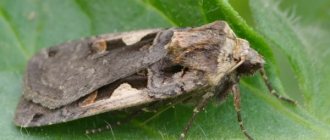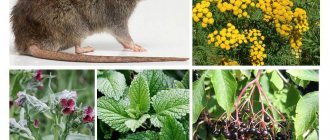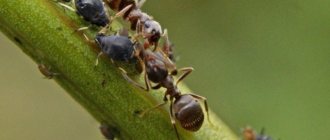What is whitefly
Whiteflies, or aleurodids, belong to the family of small homoptera insects. There are about 1,550 species of whitefly.
Greenhouse or hothouse whitefly poses a danger to tomato plantings.
The pest is widespread. Infection occurs from imported plants, less often - as a result of independent flights.
For the development of the insect, a warm, humid climate is necessary, so the whitefly appears mainly in greenhouses and greenhouses. Under favorable weather conditions, moths in temperate latitudes begin to appear in mid-June. The whitefly remains constantly active only in the southern regions.
Biological features
From egg laying to the appearance of mature whiteflies, it takes from 22 (at +24 ºС) to 60 (at +12 ºС) days . The most favorable temperature for the pest is +18 - +24 ºС. At +30 ºС, the life expectancy of moths is sharply reduced, sometimes up to four days. The lower limit for the development of embryos, larvae and nymphs is +7 ºС.
The lifespan and fertility of moths also depends on the food plant. When settling on tomatoes, the oviposition period is 15-17 days and the female manages to lay 35-40 eggs. On average, the size of the insect population increases 10 times per generation.
The life of a whitefly is divided into 4 stages: egg, larva, nymph, and mature individual (imago).
A description of each of them is given in the table.
| Stage | Where to look | Description | Duration |
| Egg | Underside of young leaves | Masonry can be crowded and scattered. The egg size is 0.2-0.25 mm, attached to the surface of the leaf with a thin stalk. At the initial stage it is pale green in color. After 1-2 days it turns brown until the end of embryo development. | 7 – 13 days |
| Larva | Bottom side of the sheet | Immediately after hatching from the egg, the size of the larva is about 0.25 mm, the body is transparent, similar to scales. She is mobile for several hours. Then it attaches to the leaf with its mouthparts and begins feeding. During its life, it releases a wax-like substance that creates a dense barrier. As it grows, the body length increases to 0.8-0.9 mm. At the end of development, it stops feeding, the body thickens, and the larva turns into a nymph. | 7 – 15 days |
| Nymph | Back of leaves | About 0.8-0.9 mm in length, whitish in color. Along the edges there are wavy bristles. At the end of the development period, a fully formed moth flies out through the formed stomata. | 10 – 16 days |
| Imago | After metamorphosing from nymphs, they remain on the same leaves, then spread up the plant | The body is white or yellowish, 1.3-1.8 mm long. The wings are white and covered with a dusty coating. Females begin to mate and lay eggs 12-20 hours after leaving the nymph. | Up to 20 days for females, 8 - 12 days for males. |
Generations of whiteflies overlap each other, so that on one plant there are insects of all stages of development: from embryos to adults.
Folk remedies
It is not safe to control the pest with insecticides during fruiting of tomatoes. In this case, mechanical methods and some homemade compositions are relevant.
Folk remedies for controlling whiteflies in a greenhouse:
Yarrow infusion
- Blooming yarrow is picked and the bucket is filled ¼ of the way.
- Then fill it completely with warm water.
- Leave for several days in a warm place.
It turns out a powerful natural infusion for spraying tomatoes. Apply 2-3 treatments to the bushes at weekly intervals, paying special attention to the lower parts of the leaves.
Garlic infusion
The caustic garlic infusion also has a detrimental effect on the pest, while at the same time protecting vegetables from fungal infections.
- Peel the garlic cloves, grate or chop in a blender.
- Pour a glass of garlic mass into 10 liters of warm water.
- After two days, strain the infusion and thoroughly spray the affected tomatoes.
It is better to alternate control methods so that the whitefly does not develop immunity to the drugs.
Helper insects
Attract natural enemies of whiteflies to save your crops without the use of dangerous chemicals:
- The ladybug fights well against aphids and eats whiteflies with appetite.
- The macrolophus bug also feeds on the pest.
- Encarsia is a parasitic creature that lays its eggs in whitefly larvae, thereby killing them. Sold in specialized garden stores, used both for private areas and on an industrial scale.
- The biological product Verticillin is based on a fungus, the spores of which penetrate the whitefly larvae, germinate and destroy them.
Why is whitefly on tomatoes dangerous?
Both adult and whitefly larvae damage tomato plants.
By feeding on plant juices, the insect damages green cells. Waste products completely or partially cover the stomata of leaf blades. The processes of photosynthesis and respiration are disrupted. Growth, flowering and ovary formation slow down.
Sooty fungus successfully develops on the sugary secretions of pests, which manifests itself in the form of a dark coating on the tops and fruits. The mycelium clogs the microscopic breathing holes on tomato foliage and interferes with photosynthesis.
The whitefly is a carrier of viral diseases. The appearance of the insect is often accompanied by outbreaks of tomato mosaic, aspermia (no seeds in the fruit), etc.
Signs of a pest infestation
The presence of whiteflies on tomato bushes is indicated by the following signs:
- White moths flutter over the beds. If you shake the plants, a swarm of insects will appear.
- On the back of the leaves, small transparent scales are visible - the larvae of the pest.
- White spots, sticky to the touch, appear on the tops - whitefly secretions.
- Leaves curl, turn yellow and fall off. The growth and formation of fruits slows down sharply.
- Dark brown spots on foliage and fruits indicate the development of sooty fungus.
Fighting methods
Methods for controlling whiteflies on tomatoes in greenhouses and open ground are similar. Only in a greenhouse it is easier to regulate the microclimate: regular ventilation will help reduce temperature and humidity.
To remove whiteflies, gardeners use insecticides and biological agents. Traditional recipes are also popular.
Biological methods
Biological methods consist of colonizing tomato plantings with natural enemies of whiteflies. The most famous entomophages are Encarsia and Macrolophus.
The use of such “biological weapons” does not harm humans, plants, or beneficial insects.
Encarzia
A representative of a large family of wasps. The adult lays eggs in the body of the whitefly larvae. The newly hatched microscopic encarsia feed on the tissues of the host’s body, and then pupate in it. The whitefly larvae turn black and mummify.
Adult encarsia feeds on the hemolymph of whitefly larvae and nymphs, destroying up to 15 pests during its life (20-40 days).
To control the number of pests, five individuals per 1 m2 are enough.
Cages with encarsia pupae are hung around the greenhouse. After about a day, the mature entomophages emerge and begin to destroy the whitefly.
Macrolophus
This predatory bug feeds on pest larvae and eggs.
The lifespan of an adult insect is 25-30 days. During this time, the bug eats up to 2500 whitefly larvae and 3500 whitefly eggs. Also, the presence of macrolophus helps remove aphids. To destroy and curb the growth of pests, 4-6 individuals per 1 m2 are needed.
Live predators are sold in special bottles with a nutrient substrate. They are released evenly over the entire planting area.
Important ! Entomophages are released in the evening and in calm weather. It is necessary to populate living organisms into the beds no later than 18 hours after purchase.
For the development of encarsia and macrolophus, temperatures of 25-27 ºС and humidity of about 70% are favorable, so they are used mainly in greenhouses.
The effect of the activity of beneficial predators appears gradually. Biological methods are best used as prophylaxis or in the initial stages of whitefly infection.
Chemicals
Pesticides are effective in the fight against whiteflies, subject to two simple rules:
With a single treatment, as a rule, only larvae and adults die - the eggs remain viable. Therefore, after 7-10 days, repeat spraying is carried out.
Insects quickly adapt and develop resistance to “chemistry”. To avoid this, drugs are used only in the doses indicated in the instructions and do not use the same drug during the season.
On a note . In case of significant damage, in order to destroy newly hatched whitefly larvae, it is useful to release the entomophages a week to a week and a half after treatment with chemicals.
Examples of popular powerful drugs against whiteflies:
- “Fitoverm” is a 5% aqueous emulsion of aversectin C. It has a nerve-paralytic effect, the death of pests occurs 1-3 days after treatment. Does not cause resistance, safe for humans. Spraying is carried out 2-3 times during the growing season with an interval of 14-20 days. The harvest can be harvested 3 days after treatment.
- " Actellik " based on pirimiphos-methyl - is available in the form of an emulsion concentrate, packaged in ampoules of 2 and 5 ml. Causes paralysis and almost immediate death of pests. Dangerous for humans and bees. Apply no more than twice per season. The waiting period before harvesting fruits is at least 30 days after the last treatment.
- " Aktara " - contains thiamethoxam. 15 minutes after treatment, the insects stop feeding and die within 24 hours. It goes on sale in the form of water-dispersible granules and concentrated suspension. Low danger to humans. Dangerous for bees. Used for root watering and spraying of plants. Can be used once. It is recommended to harvest the crop no earlier than three days after using the drug.
Important ! When working with chemicals, strictly follow the instructions and observe safety precautions.
Folk recipes
For preventive purposes and with a small number of pests, experienced vegetable growers recommend treating tomatoes with folk remedies.
Popular tinctures for whitefly:
- Garlic . 15 g of crushed garlic cloves are poured into 100 ml of water and left for 5 days. For spraying, 5-6 ml of the resulting concentrate is diluted in 1 liter of water.
- From yarrow . 200 g of chopped herbs are poured into 3 liters of boiling water and left for 2 hours. Strain and spray the tomato bushes.
- Tobacco _ 100 g of tobacco or shag are infused in 1 liter of water for two days, filtered and the beds are treated.
When spraying, the leaves are well moistened on both sides. Infusions should be used every 3-4 days throughout the growing season.
To combat moths, special traps are effective. They are easy to make yourself. Grease a sheet of bright cardboard (for example, red or yellow) with honey or Vaseline and place it on the garden bed. The butterflies will flock to the bright bait, stick to the paper and die.
Preventive measures against whitefly on tomatoes: how to protect tomatoes in a greenhouse
Remember! It is easier to prevent any problem than to fix it later.
To prevent the appearance of whiteflies, it is recommended to take the following preventive measures:
- Conduct regular preventive inspections for the presence of pests in the greenhouse.
- Promptly destroy weeds.
- Observe the growing conditions of the crop.
By the way! The site has detailed material on how to properly grow and care for tomatoes in a greenhouse .
- Proper use and care of the greenhouse, namely:
- every autumn and/or spring you should clean (take out all vegetation) , including steaming or freezing the soil in the greenhouse (if you are a resident of the southern region);
By the way! How to properly prepare a greenhouse in the spring for the planting season is described in this material , and it the fall in this article .
However, it is worth considering that, unlike spider mites, whiteflies do not survive on the surface in the greenhouse, only in the soil.
- provide adequate ventilation in the greenhouse;
- carry out other preventive measures and use special protective equipment and control methods.
Advice! To protect greenhouse tomatoes, it is optimal to use biological agents (parasites and predators) and glue traps. If these do not help control the whitefly population, then use chemical agents.
Video: how to get rid of whiteflies in a greenhouse in the fall
Preventive actions
To protect against the appearance of whiteflies, the following measures are effective:
- Cleaning the beds of all plant debris.
- Autumn and pre-planting preparation of greenhouses: cleaning of all garters and equipment, washing of structures and disinfection of the premises with insecticides.
- Freezing greenhouses before snow falls.
- Inspection of seedlings. Instances with signs of infection are immediately disposed of.
- Regular ventilation of greenhouses.
- Plant no more than two tomato bushes per 1 m2 for tall varieties and no more than four for medium-sized ones.
- Compliance with the regime of watering and fertilizing plants.
How to prevent pests from appearing in greenhouse tomatoes
A number of rules for keeping tomatoes in a greenhouse that will help avoid infection:
- In the fall, be sure to dig up the soil for planting tomatoes to the depth of a spade bayonet.
- Remove weeds and bush residues after harvesting and burn them.
- Plant tomatoes at intervals so that the plantings are not crowded.
- Follow the rule of crop rotation.
- Disinfect all greenhouses and equipment before and at the end of the season. In winter, during cold weather, you need to freeze the greenhouse by opening the windows and doors.
- Spill the soil with a solution of copper sulfate (200 g per 10 liters of water).
- Ventilate the greenhouse daily to avoid increased humidity.
- Choose greenhouse tomato varieties that are resistant to pests.
- Use fumigators against mosquitoes and flies, they also repel insects.
The fight against whitefly must be comprehensive and attentive. A careless gardener can lose most of his harvest due to a voracious pest. Don’t give up and combine several control methods at once, alternate strong insecticides, use sticky traps and don’t forget about preventive measures.
Here is the long-awaited summer tomato harvest. How do you like it? All this can be obtained if you take care of your plants, water them, care for them, and feed them. And you will succeed.
